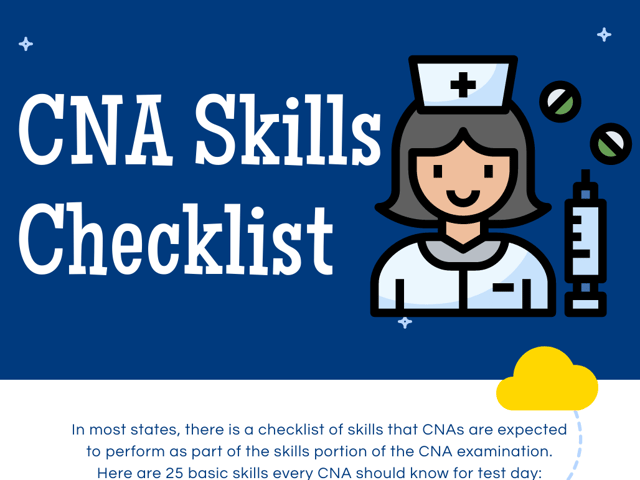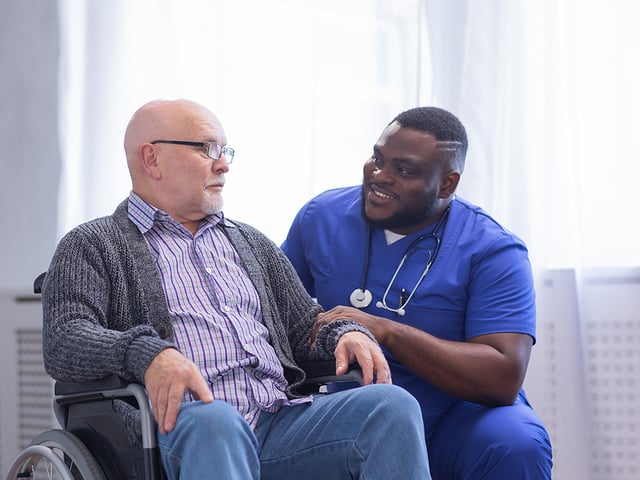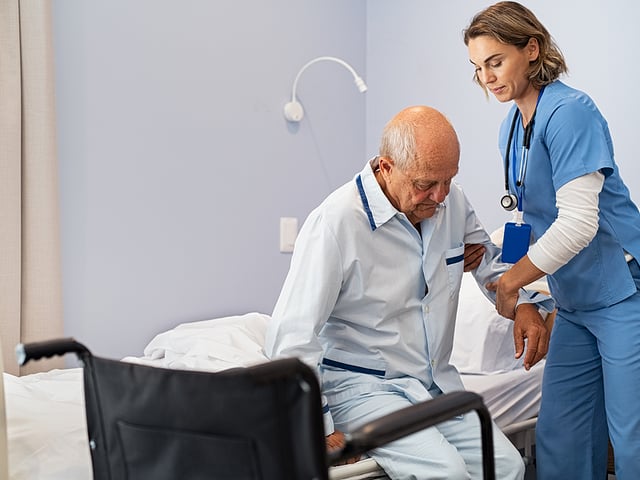
25 CNA Skills to Know and Be Able to Perform
Becoming a Certified Nursing Assistant (CNA) is a rewarding career choice. CNAs play a pivotal role in the healthcare industry by providing direct patient care, often forming strong bonds with their patients. The training is rigorous, but necessary to ensure CNAs are prepared for any situation they may encounter on the job.
One of the most challenging aspects of CNA training is the skills test. This is an examination where candidates are expected to perform a checklist of practical skills. These skills range from maintaining personal hygiene and safety, to providing physical support, assisting with personal care, and measuring vital signs.
In this blog, we introduce you to the 25 skills typically required for the skills part of the CNA examination. Remember, learning these skills is not only about passing your exam, but also about being prepared to offer the best care to your future patients. As a CNA, your duty will be to provide compassionate and competent care, making a difference in the lives of the patients you serve. With a clear understanding and mastery of these 25 skills, you’ll be well on your way to becoming an effective and successful CNA.
The 25 CNA Tested Skills
This is the entire list of skills and a brief description of each.
-
Handwashing—As simple as this may sound, handwashing is one of the most critical skills that a healthcare professional must master. This technique ensures that you’re not transmitting infections to patients and also protects you from acquiring infections. It involves using soap and water to thoroughly cleanse your hands, paying special attention to areas such as underneath the fingernails and between the fingers. You should wash your hands for at least 20 seconds and then dry them properly. It’s not just about being able to do it, but understanding when to do it—before and after patient contact, after removing gloves, after contact with bodily fluids, and before and after eating or using the restroom.
-
Donning and Doffing Gown and Gloves—With the emergence of diseases like COVID-19, the importance of using Personal Protective Equipment (PPE) has never been more emphasized. Donning (putting on) and doffing (taking off) PPE such as gowns and gloves correctly is crucial to prevent the spread of infections. This includes understanding the proper sequence of putting on and removing PPE and ensuring that used PPE is discarded safely.
-
Positioning in Fowler’s Position—Fowler’s position refers to an upright or semi-upright position (45-60 degrees) that a patient is placed in when they’re short of breath or for certain medical procedures. It involves adjusting the bed and using pillows for support. When positioning a patient in Fowler’s position, it’s essential to ensure their comfort and safety, particularly to prevent pressure ulcers or falls.
-
Positioning in Lateral Position—The lateral position involves positioning the patient on their side. This position can aid in comfort, promote lung expansion, and prevent pressure ulcers. When positioning a patient laterally, you must support their alignment using pillows and regularly turn them from side to side to prevent bed sores.
-
Transferring from Bed to Chair Using a Gait Belt—Some patients may have difficulty moving from a bed to a chair. As a CNA, you will often use a gait belt—an assistive device—to safely assist them. This involves positioning the belt correctly around the patient, ensuring you have a proper grip, and using your legs (not your back) to lift.
-
Assisting the Resident in Walking Using a Gait Belt—Gait belts are also used to help a patient walk, especially if they have balance or strength issues. The belt provides a handle for you to hold onto, offering support and reducing the risk of falls. It’s crucial to monitor the patient’s status during ambulation and be ready to assist if they become weak or dizzy.
-
Making an Occupied Bed—Bedridden patients often require their bed linens changed while they are still in bed. This task can be challenging but is essential for the patient’s comfort and hygiene. It involves understanding how to maneuver and turn the patient safely, maintain their privacy, and efficiently change soiled linens without causing discomfort.
-
Passive Range of Motion on the Upper Body—Patients who have difficulty moving their arms, shoulders, and hands can benefit from passive range of motion exercises. These are exercises that you, as the CNA, will perform on the patient to help maintain joint flexibility, promote circulation, and prevent muscle atrophy. They involve gently moving each joint in the upper body through its full range of motion.
-
Passive Range of Motion on the Lower Body—Similarly, patients who are not walking need these exercises for their lower body joints. It involves moving the patient’s hips, knees, ankles, and toes in a specific range to stimulate muscle activity and circulation and prevent stiffness and bed sores.
-
Brushing Dentures—Dental hygiene is vital for all patients, including those with dentures. As a CNA, you might need to assist patients in removing, cleaning, and caring for their dentures. This involves handling the dentures carefully to avoid damage, cleaning them with a soft denture brush and non-abrasive cleaner, rinsing them thoroughly, and storing them in a clean denture container with water. You should also ensure that the patient’s mouth is cleaned properly after removing dentures.
-
Mouth Care—Oral care is a crucial part of overall hygiene, especially for unconscious or bedridden patients who cannot perform these tasks themselves. It involves using a toothbrush or sponge stick to clean the teeth, gums, and tongue. Special attention must be given to avoid choking or injury and to ensure thorough cleaning to prevent gum disease, tooth decay, and infections.
-
Upper Body Partial Bed Bath—This refers to washing the parts of the body that can be exposed without removing all the patient’s clothing, such as the face, hands, arms, underarms, and back. For patients with limited mobility or those who are unconscious, you need to ensure their comfort and privacy during the process. Using warm water, mild soap, and a gentle touch, you cleanse, rinse, and dry each part before moving onto the next to maintain the patient’s body temperature and hygiene.
-
Lower Body Partial Bed Bath—Just as with the upper body, many bedridden patients will need assistance bathing their lower body, which includes the waist, legs, and feet. Here, the focus is on maintaining the patient’s dignity, comfort, and warmth while ensuring cleanliness. Be particularly careful with areas prone to pressure sores, such as the heels.
-
Providing a Back Rub/Massage—Back rubs or massages are used to stimulate circulation, relieve muscle tension, and provide comfort. Using lotion or oil, apply gentle pressure in a circular motion to massage the patient’s back. It’s crucial to ask about comfort and to be careful not to massage over bony prominences or sores.
-
Female Perineal Care—Proper perineal care is essential to prevent infections and skin breakdown in female patients. This includes washing the urinary and anal areas, rinsing thoroughly, and patting dry to prevent moisture buildup. Always clean from the cleanest area (the front) to the dirtiest (the back) to avoid cross-contamination. Gloves and gentle hypoallergenic, unscented soap should be used for this sensitive area.
-
Shaving—Shaving can help patients maintain their appearance and feel better about themselves, but it also needs to be done with caution. You will need to use a safety razor or electric shaver, prepare the skin with warm water and shaving cream, and shave in the direction of hair growth to reduce the risk of cuts and skin irritation. Always check the patient’s care plan for any restrictions or preferences about shaving.
-
Fingernail Trimming—Keeping a patient’s nails clean and trimmed can prevent injury and infection. When trimming nails, it’s important to use proper tools, such as a nail clipper and file. Trim straight across and then round the tips in a gentle curve, making sure not to cut too close to the skin or into the corners, which can cause injury or ingrown nails.
-
Assisting Dressing with an Immobile Arm—Dressing with an immobile arm is challenging, and patients will need assistance. As a CNA, you’ll help put on a shirt or jacket by starting with the affected arm first, moving gently to avoid causing pain. It’s also important to respect the patient’s choices in clothing and maintain their privacy during the dressing process.
-
Serving and Feeding a Paralyzed Patient—Patients who are paralyzed often require assistance with meals. This could involve serving food and drinks, but also may require physical feeding. It’s important to sit at the patient’s level, encourage self-feeding when possible, and offer small bites. Special precautions, such as ensuring the patient is in an upright position and swallowing completely before the next bite, are necessary to prevent choking and aspiration.
-
Assisting with Bedpans—Bedpans are used for patients who cannot get out of bed to use the restroom. Assisting with a bedpan involves careful placement under the patient, providing privacy, and cleaning the patient afterward. It’s essential to wear gloves and wash your hands before and after to prevent infection. Remember to offer hygiene wipes and help the patient wash their hands after use to promote cleanliness and dignity.
-
Measuring Height—An upright scale with a height rod, also known as a stadiometer, is usually used to measure a patient’s height. For this, the patient should be standing straight without shoes, and their heels, buttocks, and upper back should be in contact with the height rod. The patient’s head should be in the ‘Frankfurt Plane’ (an imaginary line passing from the ear canal to the lower border of the eye socket). The measurement is then recorded in feet and inches or centimeters.
-
Measuring Weight—Using an upright scale, also known as a balance beam scale, to measure a patient’s weight provides the most accurate results. The patient should remove heavy outer clothing and shoes and stand still on the center of the platform. The weights on the scale are then adjusted until the balance beam is level. The weight should be recorded in pounds or kilograms.
-
Recording Radial Pulse—The radial pulse is an important vital sign that indicates the heart rate and rhythm. To measure it, you will locate the radial artery on the inside of the wrist, just below the thumb. Using your index and middle fingers, you will apply slight pressure and count the beats for 60 seconds. It’s crucial to note the rhythm and strength of the pulse as well.
-
Recording Respirations—Respiratory rate is a critical vital sign indicating how many breaths a person takes per minute. To measure it accurately, do not inform the patient that you are assessing their breathing, as people may unconsciously alter their breathing if they know it’s being watched. Count the rise and fall of the chest for 60 seconds. Make sure to note any difficulty in breathing or abnormalities in the breathing pattern.
-
Recording Blood Pressure—Blood pressure measures the force of blood against the walls of the arteries. For a manual measurement, you’ll use a sphygmomanometer and a stethoscope. Position the cuff around the patient’s upper arm at heart level, locate the brachial pulse, and place your stethoscope there. Inflate the cuff until you no longer hear a pulse, then slowly deflate it while listening for two distinct sounds. The first sound heard (systolic pressure) and the point when the sound disappears (diastolic pressure) are recorded as the blood pressure reading.
Get Ready to Pass the CNA Skills Test!
Mastering these 25 CNA skills is crucial not only for your success in the CNA skills test but also for your overall effectiveness as a healthcare professional. You are expected to perform these tasks proficiently, while ensuring the patient’s comfort, safety, and dignity at all times. It may seem daunting at first, but with consistent practice and the right resources, you’ll be well-equipped to provide excellent patient care.
To prepare for your CNA skills test, using resources such as CNA practice tests, study guides, and flashcards can be tremendously beneficial. These tools can help you familiarize yourself with the procedures and principles underlying each skill. Practice tests allow you to gauge your understanding and readiness for the actual exam, while study guides break down each skill into manageable steps. Flashcards, on the other hand, can be a handy way to review and reinforce your knowledge.
Remember, becoming a CNA is about more than passing a test; it’s about gaining the skills and knowledge necessary to make a positive impact in the lives of those you serve. Therefore, approach your studies with an open mind, a willingness to learn, and a commitment to providing the best patient care.

Keep Reading

Certified Nursing Assistant Exam Blog
How Long Does it Take to Become a CNA?
As a profession on the frontline of healthcare, Certified Nursing Assis…

Certified Nursing Assistant Exam Blog
How to Do Well on the CNA Skills Test
Over 1.3 million nursing assistants work in our healthcare system today…

Certified Nursing Assistant Exam Blog
What Does a Nursing Assistant (CNA) Do?
Are you interested in exploring medical careers? The healthcare industr…